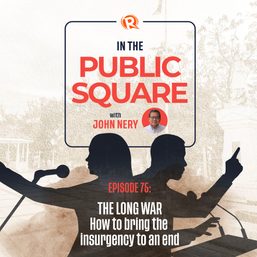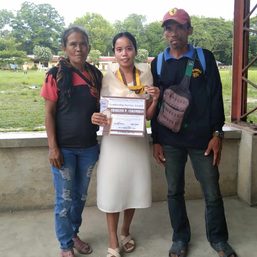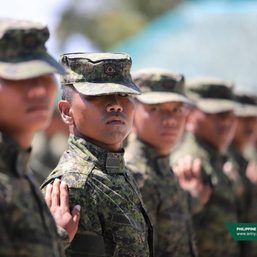SUMMARY
This is AI generated summarization, which may have errors. For context, always refer to the full article.
![[Newsstand] Time to negotiate peace again with the CPP-NPA](https://www.rappler.com/tachyon/2024/05/negotiate-peace-again-may-10-2024.jpg)
A new report by the International Crisis Group published in April concludes that the “Maoist insurgency in the Philippines is at its lowest ebb in decades.” From a high of 25,000 armed regulars in the last years of the Marcos regime, the number of rebels is down to somewhere between 1,200 and 2000 – roughly speaking, close to the same number when the first President Marcos used the then-new insurgency as a pretext for imposing martial rule in 1972.
The insurgency is hampered by serious organizational challenges, including “perhaps the most severe leadership crisis in its history” (provoked not only by the death of its founder but also by “the killing [by the Philippine military] of several high-ranking commanders over the last three years”); a reduction in revenues generated from so-called revolutionary taxation (because of the loss of territory and “the arrest of financial operatives”); and internal confusion (“differences among cadres regarding the movement’s political and military direction”).
These and other crises can be seen reflected, even without the benefit of context, in the message the Communist Party of the Philippines published to mark its 55th anniversary. Without reference to the combination of military pressure and development outreach that the government has been leveling against the insurgency, the message may read as yet another (though still remarkably candid) exercise in the revolutionary discipline of “criticism and self-criticism.”
But read in the context of the rebellion’s continuing loss of leaders, fighters, base areas, resources, and informal support structures, these passages from the December 26, 2023, message confirm that the movement is, in fact, in bad shape.
The message recognized that “not a few guerrilla fronts of the [New Peoples Army] stagnated and got stuck for a long time at the old level.” The cause, however, was identified as “some Party leaders,” who “self-constricted the NPA to its reliable guerrilla base areas and mountain encampments, limiting the scope or range of military and political initiative of the Party and NPA.
Self-constriction goes against the need for guerrilla units to constantly move forward and advance, and to be always on offensive footing. Reliable guerrilla base areas were eventually reduced to a few ‘favorite’ or ‘comfort zone’ barrios, communities or mountain encampments with easy access to mass support, supply lines or communication facilities.”
Military conservatism
The message developed its argument with even more candor:
“Self-constriction and loss of initiative leads to military conservatism, as points from which the NPA can hit the enemy became limited or inaccessible. Other concomitant problems that arise include gathering intelligence, sources of supply, communications, and so on. The NPA could not readily carry out an ambush at the highway because its main forces are encamped in the interior areas. Mounting raids, ambushes, and other basic tactical offensives became increasingly cumbersome and time-consuming. They became content with attrition tactical offensives (harassment, sanctions and so on) and lost sight of the need to mount sustained annihilation or basic tactical offensives as the principal component of our strategy to weaken the enemy part by part and steadily strengthen the people’s army.
“In a significant number of guerrilla fronts which had company-sized or multiple-platoon-sized forces, some Party leaders became complacent and self-assured. There were cases of over concentration of forces in some regions or sub-regions, where two or more guerrilla companies are brought together in a mountain encampment over extended periods of several months, to conduct trainings, education courses, prolonged meetings or to await execution of an ill-planned offensive, leaving less [sic] forces and less time for mass work. These prolonged encampments caused a heavy strain on the organized masses and militia forces who have to work hard to keep the supply lines running. These also cause guerrilla discipline to slacken and ‘civilianize’ guerrilla forces. Some NPA units have encountered problems of drinking among guerrilla fighters.”
And so on, in this vein. The Crisis Group report characterized the CPP as “mindful of these challenges,” and summarized the message of December 2023 (and that of March 2024 too) as a call to “galvanize the movement” and “reinvigorate political and logical education for cadres and combatants.”
Peace talks
Does it make strategic sense for the Philippine government to restart peace talks with the CPP-NPA and its National Democratic Front? The joint announcement last November of an agreement to resume peace negotiations was a real surprise – and was met with a mix of skepticism and hope. The skeptical response raised suspicions about political maneuvering ahead of the 2025 midterm elections; when Ferdinand Marcos Jr. ran again for the Senate in 2010, he was on the same slate as Bayan Muna’s Satur Ocampo and Gabriela’s Liza Masa. The hopeful stance recognized that one of the administration’s signatories of the Joint Statement for Peace was Special Adviser to the President Anton Lagdameo, President Marcos’ closest friend.
But if the insurgency is at its weakest, why even attempt to strike a peace deal? Shouldn’t the government continue its current campaign mixing military pressure and development outreach until the last base area is recovered, the last guerrilla front overrun?
It has already been about a decade since the national security establishment under the second Aquino administration came to the conclusion that the communist insurgency was no longer the country’s main national-security threat. The pivot to external defense or territorial defense operations (TDO) under the second Marcos administration formalizes the downgrading of the insurgency. Peace negotiations will help ease the pivot to external defense.
That is the first reason why the Marcos administration should return to the negotiating table. The second reason is the law of diminishing returns; the counter-insurgency campaign that has helped reduce the size of the NPA by about half, since Rodrigo Duterte came to power, may have already reached its optimal phase.
Besides, the kind of justification often offered by those who would like the current campaign to continue is very much along the lines of “crushing” the rebellion. The rebels are on the run, why stop hot pursuit? Because history’s lesson is clear.
According to “Paths to Victory,” the 2013 RAND Corporation study of 71 insurgencies (updated from its influential 2010 study of 30 insurgencies, titled “Victory Has a Thousand Fathers”), the so-called “iron fist” path succeeds “only 32 percent of the time,” while its opposite approach, the so-called motive-focused path, succeeds 73 percent of the time.
The iron fist approach to counterinsurgency (COIN) focuses primarily on “eliminating the insurgent threat,” while the motive path addresses “the motives for beginning and sustaining the insurgency.” In other words, the iron fist seeks to hammer the insurgents to oblivion, while the motive-focused approach resolves the conditions that gave rise to and supplies the insurgency.
And the lesson from the history of insurgency from 1944 to 2010 is that the COIN odds do not favor the use of force alone. To quote the 2013 study: “The importance of reducing insurgents’ tangible support is the center-most finding of this research. Successful COIN forces reduce not only the active insurgents but also the support that fuels the insurgency.”
But the Philippine Army, by far the largest of the services, has more invested in continuing the counterinsurgency campaign than any other institution; it is, hyperbolically, the only thing they know. They (and the Duterte political alliance) may stand in the way.
Weaker position
Does it make strategic sense for the communist insurgency to enter into peace talks? As the scattered leadership must be only too aware, they will be returning to the negotiating table with a much weaker position. But they do own a conspicuous advantage: They offer the second President Marcos the historic opportunity of ending the insurgency that started under the first President Marcos.
If the Marcos family were serious about rehabilitating their family name, concluding real peace with the communist rebels would rank high among the pathways to rehabilitation – not as high as paying their billion-peso tax arrears or returning their ill-gotten wealth, but high enough to cement their new reputation in Western capitals.
But peace talks may also result in the suspension of red-tagging and red-baiting by government and military officials (the provocative actions of Duterte supporters is a different problem altogether), and may create the momentum necessary to review and improve the work of the task force overseeing the government’s COIN campaign. Not the abolition that UN Special Rapporteur Irene Kahn had strongly recommended (that looks outside the realm of political probability), but at least a change that renders it more community-oriented, more representative, more civilian. (The Crisis Group makes the same recommendations.)
Time to talk peace again. – Rappler.com
Veteran journalist John Nery is a Rappler columnist, editorial consultant, and program host. In the Public Square airs on Rappler platforms every Wednesday at 8 pm.
1 comment
How does this make you feel?




The central issue here is whether President Marcos Jr. recognizes the significance of the peace negotiation between the Government and Communist insurgents as a crucial step towards ending the insurgency initiated under the first President Marcos. Underlying such recognition is the ambition of outdoing his father in counter-insurgency and political leadership. But I believe that his ambition is separate from this one. He is most focused on having the Marcos-Romualdez Political Dynasty continue its grip on the Presidency. Unless such counter-insurgency achievement significantly supports the goal of his Political Dynasty, then he may do so. This could be done by staging deceptive peace negotiations for political propaganda only.